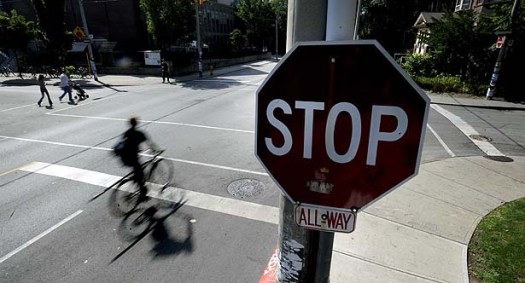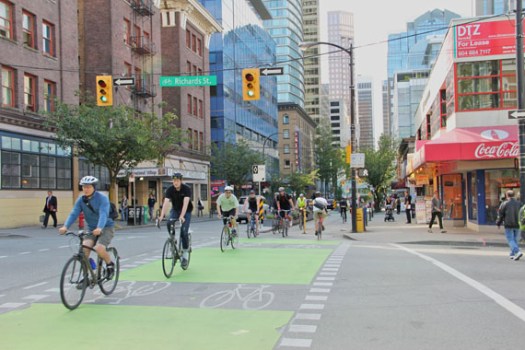The Stories About Those Who Walk (And Bicycle) To Work
When we heard recently about a young black man stopped by police while riding a bike on his way home to Asbury Park from work many miles away, this article resonated. We’re being confronted by the reality that in places like Asbury Park, employment may be out of reach unless you have the means to own a car. This young man being stopped while riding his bike and ultimately charged has brought us to a critical moment. We believed that Asbury Park was becoming a model as a community that works to bring people together and supports social justice. We have work to do.
Stories About Marathon Walking (*Or bicycling*) Commuters Receiving Benevolent Donations of Cars Are Actually Terrible
These stories aren’t heartwarming. They highlight systemic, persistent injustice that goes unaddressed.
By
The work ethic and determination of these men is stunning, but don’t paint their stories as triumphs of the American spirit. When we hear about desperate, exhausting commutes to jobs far away from home, we’re being confronted by the reality that in places like Birmingham and Detroit, employment is out of reach unless you have the means to own a car.
Dig into the story a little bit and there are other red flags. For example, Carr was picked up by police because he was walking (while black), and the officers took him out for breakfast when “his story checked out,” reports Carol Robinson at the Birmingham News. What appears as a friendly interaction in the article began as an instance of racial profiling, where Carr had to prove his worth as a human being.
Read about it:
Or Listen:
https://www.wnycstudios.org/story/walking-work-stories-heartwarming-or-harmful
WHAT?? Legal For Bike Riders To Run Traffic Lights?
We constantly hear and read complaints from drivers: “Bike riders don’t obey the law!” “Bike riders think they are entitled to run stop signs!” You might be surprised to learn that it’s legal—and the reasoning will help you understand how we can build our places better for everyone. Important takeaway: Bike riders are not cars. They are people.
Here are 2 items in the list:
5. No, most cyclists don’t want to be “treated like cars.” They want to be treated like humans.
Another of the most common misconceptions I hear from drivers is, “If cyclists want to be treated like cars, then why do they [insert transgression here]?!?!” To which I usually respond, “Well, first of all, they don’t.”
Bicycles are not cars. They don’t move like cars, take up the same amount of space as cars, or operate at the same speed as cars. It doesn’t make sense to pretend otherwise, and consequently, it doesn’t make sense to apply all auto-oriented traffic laws to cyclists. As described earlier, while laws like the Idaho Stop may seem counterintuitive, they can actually decrease collisions. So can installing bicycle-specific lights, such as those in Paris.
Most cyclists I know, myself included, have no wish to “be treated like cars.” We want to be treated like people. We mostly would like to operate and occupy space on the road without our lives being threatened.
6. Cyclists don’t commit more infractions than cars, and seeing a cyclist break the law isn’t a reason they “shouldn’t be on the roads.”
This one is admittedly more anecdotal. But everything from my personal conversations with friends and family about cycling, to the conversation on my local radio shows, to every comment I’ve ever read on an article about cycling—hones in on this one thing. It always comes back to that one time you saw a cyclist running a light, running a stop sign, not wearing a helmet, or committing some other unforgivable sin on the street that only seems unforgivable when a cyclist does it. I’ve literally had this conversation on the patio of a coffee shop while watching seven cars roll the stop sign outside within a matter of minutes.
Motorists commit traffic infractions and do it often. I have never heard this used in a conversation about the viability of cars on the road. So the question becomes: why is this so often used in the conversation about the viability of bikes? I don’t have control over other cyclists on the road. Some of them break laws or don’t signal correctly. Sometimes drivers assume cyclists have broken laws when actually they haven’t, as explained above. Both scenarios should be irrelevant to the conversation about creating better bike infrastructure.
APP: iStar Agrees to Meet With Asbury Park To Redesign Waterfront
APCSC advocates for equitable access for everyone throughout the city of Asbury Park. We are confident that the city of Asbury Park and iStar will be diligent supporting “a planning process that supports a “community-based” vision for the redesign which he said should include a long term solution for the Bradley Cove development site.”
|
ASBURY PARK – iStar has agreed to meet with city officials to “begin the redesign process” of controversial infrastructure improvements under way at the north end beachfront.
Brian Cheripka, iStar’s senior vice president of land and development, said in a letter to the city that the city’s master waterfront developer is “willing to come back to the table to discuss the project.”
Mayor John Moor said the letter is a step in the right direction between the city and iStar and that “middle ground” can be reached on the project when the two sit down at the scheduled Nov. 30 meeting.
iStar to meet with Asbury Park after north end boardwalk plan slammed
APSUN: ISTAR OPEN TO REVISE NORTH ASBURY BEACHFRONT PLAN
Asbury Park’s boardwalk is a thoroughfare through the city north to south. It must be (and feel) safe and accessible for everyone, from the residents of the senior tower to the children from every neighborhood in the city. We’re confident that iStar realizes that they are partnering with the city for the long term, and will foster a good relationship going forward by being engaging and transparent throughout the development of the waterfront.
An excerpt from a letter to iStar from Save Asbury’s Waterfront:
1. Maximize social inclusion and provide access for all residents and visitors
2. Recognize current coastal development guidelines and practices
3. Be sensitive to biodiversity, wildlife habitats, pollution and other environmental concerns
4. Be transparent during all phases of planning and implementation
CHERIPKA SAYS LONG-TERM VISION INCLUDES SOLUTION TO BRADLEY COVE SITE
Read about it:
http://asburyparksun.com/istar-open-to-revise-north-asbury-beachfront-infrastructure-plan/
VisionZero Day Of Action: Attention to Preventable Traffic Deaths
On Sunday, November 18th communities across U.S., and around the globe organized for World Day of Remembrance for Road Traffic Victims.
Asbury Park has thankfully not had traffic deaths that other larger cities have had. Let’s not wait until a tragedy happens to implement traffic calming measures all over the city, and #slowthecars.
|
Every day 100 people will die in U.S. in preventable crashes. How is our community doing? Yesterday Sunday, November 18th was World Day of Remembrance for Road Traffic Victims #WDoR2018 to honor those who lost lives. We join VisionZero Network and urge action for #VisionZero.
Read more…
What is Tactical Urbanism? An International Movement
“Cities around the world are using flexible and short-term projects to advance long-term goals related to street safety, public space, and more.”
APCSC and other Complete Streets advocates believe that streets are for people. We know that even with best intentions cities sometimes miss opportunities, or are financially challenged to effect changes away from car-centric streets. We can get creative to make streets into places for people: for health, for social well-being, for the environment, and for economic benefit.
Tactical Urbanism is all about action. Also known as DIY Urbanism, Planning-by-Doing, Urban Acupuncture, or Urban Prototyping, this approach refers to a city, organizational, and/or citizen-led approach to neighborhood building using short-term, low-cost, and scalable interventions to catalyze long-term change.
Learn about it:
Post-Turkey Day Bike Ride
The #MeToo Movement And Street Infrastructure
This article is about Seattle, but we can substitute: Asbury Park is working to “advance its most prominent public asset — our streets — toward a bold vision for inclusivity across gender, race, ability and class by making it safe, efficient, and intuitive for all modes of transportation to access…” every part of the city. Walking and biking offer a barometer — and a proving ground — for women’s belonging in public space.”
It’s time Seattle planners listen to women who walk and bike
Claire Martini November 12, 2018

(Matt M. McKnight/Crosscut)
The #MeToo movement enables women to speak out about injustices faced behind closed doors. But injustice can also hide in plain sight, stemming from something as basic as the way streets are built.
Safety is paramount. While planners focus on delivering miles of bike lanes and sidewalks, women’s calculus is more complex: “Women and girls have to account for threats and realities of gender-based violence in public—on public transportation, in schools, in workplaces, in parks, on streets,” writes urbanist Tiffany Lam. Women, trans, femme, non-binary cyclists and particularly people of color experience racial and gender discrimination while biking (according to a study in Portland),while shouldering concerns about parenting, appearance, personal safety and harassment. Recognizing that “human infrastructure” supports would-be cyclists, many communities organize rides, skill workshops and education programs; we need leaders in access and mobility at every level of our city, from living rooms and classrooms to City Hall.
Read more…
https://crosscut.com/2018/11/its-time-seattle-planners-listen-women-who-walk-and-bike
It’s About A Better City
It’s about a better city, not about riding bikes or walking, or certainly not a “war on cars”. Many people (or most) who ride bikes and walk also drive a vehicle. We’re all in this together. Asbury Park is finalizing the Asbury Park Bike and Walk Master Plan which will create a network for safe walking and bicycling .
“…a few separated routes through a large, still car-dominated city and region don’t create a viable choice in how to get around for people aged 8-80. For people of both genders and all ages to choose a mode of movement a system or network is needed – complete, connected, efficient, predictable, and safe in both perception and reality.”
It’s Not About The Bike Or Car —It’s About Better Cities
“I don’t consider myself a ‘cyclist.’ Calling myself that would seem as odd as calling myself a walker, a transit-rider, or a driver. I’m someone who loves living in cities, who has studied how cities work all of my adult life. Really, I’m a citizen.”
Read more…
http://spacing.ca/vancouver/2012/10/08/its-not-about-the-bike-or-car-its-about-better-cities/















